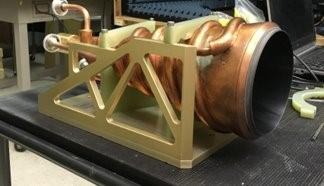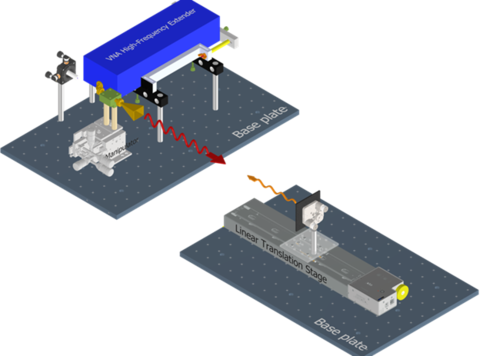Summary
Small satellites have shown a significant promise at a fraction of cost and size as their performance is comparable to, if not better, that of conventional large satellites. A joint project among NIST, CSU, Duke University, and Northrop Grumman aims to improve remote-sensing calibration standards, leading to significant accuracy and congruence improvements in satellite data. The NASA-funded project calls on NIST’s long-standing expertise in microwave radiometer calibration to develop new technology standards that will enhance instrument evaluation, increase data repeatability among instruments, and enable constellations of CubeSats to provide microwave-sounding data more reliably. In addition to representing a major step forward for the microwave community, the work will enable effective calibration and traceability between microwave instruments on satellites in space.
Description

NIST Calibration Target
The small-satellite development has seen significant growth in recent years. Due to the size limitation, the conventional calibration device can no longer be equipped on the small-satellite platform. Consequently, new technology is called for to provide a precise and traceable calibration solution to small weather satellites, such as CubeSats and NanoSats. This three-year project will develop a NIST-traceable Miniaturized Microwave Absolute Calibrator based on printed-circuit boards (PCBs) made of Metamaterials at millimeter-wave sounding channels from 50 to 220 GHz.
This unique opportunity will give NIST the ability to connect to industry, gather data and refine the established traceability standard and apply it to satellite calibration. Many realizations of microwave satellite calibrators exist in the form of thermally managed calibration targets, but none are currently maintained as a national standard by a national metrology institution. By extending NIST traceability to real-world satellites, industry will have constant reference for comparison of different instruments over upcoming decades. A stable, accessible reference benefits studies of long-term phenomena such as climate change and may lead to improved weather forecasts.
The goals of the project include:
- Improve passive microwave remote sensing instruments through fundamental size, weight, and power reductions enabled by thin, planar metamaterial microwave absorbers
- Improve calibration and inter-calibration of passive microwave sensors through the development and validation of SI-traceable brightness temperature calibration
- Extend SI-traceable calibration to metamaterial absorber-based calibration target for use in CubeSat microwave sensors.

Approach:
-
Design, fabricate and characterize metamaterial absorber calibration targets for operation from 50 GHz to 220 GHz (collaborative effort – Duke lead)
-
Validate metamaterial microwave absorber calibration targets through on-axis reflectivity and radiometer measurements in the anechoic chamber at NIST (collaborative effort – NIST lead)
-
Validate thermal performance of NIST prototype brightness temperature calibration standard through modeling and measurements in a thermal vacuum chamber (NIST/Northrop Grumman/CSU)
-
Extend traceability path for metamaterial absorber calibration target through radiometric system uncertainty analysis (NIST/CSU)
Major Accomplishments
-
Fabricate & characterize metamaterial absorber prototypes 09/21
-
Complete thermal modeling of NIST calibration standard 09/21
-
Complete test plan for NIST standard in TVAC chamber 03/22
-
Validate thermal uniformity of NIST calibration standard 03/22
-
Fabricate & characterize metamaterial super unit-cell 01/23
-
Complete thermal evaluation of NIST standard in TVAC 07/23
-
Characterize optimized metamaterial super unit-cell 01/24
-
Complete measuring on-axis reflectivity of metamaterial 01/24
-
Complete radiometric measurements of metamaterial 07/24
-
Extend traceability path for metamaterial absorber target through radiometric system uncertainty analysis. 07/24

